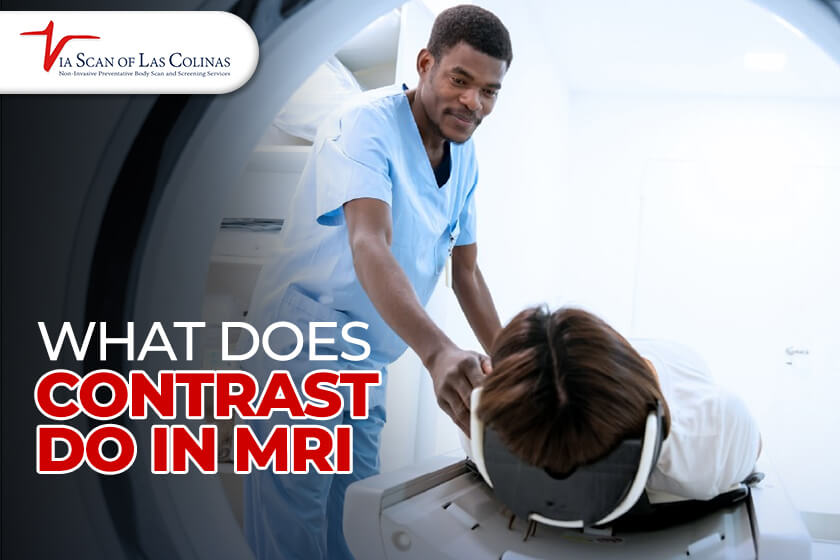What Does Contrast Do in MRI?

With its ability to provide precise pictures of the inside organs, magnetic resonance imaging (MRI) has emerged as a vital tool in contemporary medicine. Consumption of intravascular contrast substances is crucial to many MRI scans. These unique colors improve the contrast between particular organs, circulatory systems, and tissues during scanning.
Individuals might feel more at ease and knowledgeable when having an MRI scan if they comprehend how MRI contrast operates and why it is employed. In this blog guide, we will discuss what MRI contrast is employed for, the many kinds of contrast scans, why specific tests may utilize contrast whereas others may not, and what to anticipate throughout an MRI scan with contrast. We will also address several essential queries, such as the cost of MRIs, the duration of various scans, and the safety of MRIs. This article seeks to simplify and make the nuances of MRI contrast understandable through the expertise of ViaScan’s skilled imaging staff.
How Many Types of MRI are there?
A few primary categories of MRI scans can be distinguished by the various imaging modalities employed:
Conventional MRI: This straightforward scan yields anatomical pictures without requiring intravenous contrast. Assessing structures such as organs, joints, malignancies, or injuries is done using it.
MRI with contrast: Also called contrast-enhanced magnetic resonance imaging (MRI) this type of imaging involves injecting a contrast substance into the circulatory system to bring specific tissues and blood circulation to the surface during the scan. A functional magnetic resonance imaging scan uses blood flow variations to assess neurological activity. It is used for brain mapping of neuronal activity.
Magnetic resonance angiography: This method uses contrast to view blood arteries and flow specifically. Evaluates the heart or blood vessels.
Tissue chemical makeup may be measured using magnetic resonance spectroscopy. Able to identify metabolic conditions. The kind of scan ordered will be determined by the diagnostic data your physician requires. Specific scans, such as brain MRI without contrast, might not require augmentation, but others will require contrast to make specific structures more accessible to see.
How Long Does an MRI take?
The duration of an MRI scan can vary greatly, ranging from 15 minutes to more than an hour, contingent upon the body part being scanned, the usage of contrast, and the number of sequences needed. The following are some average MRI times:
MRI of the brain or skull, for a spine MRI, an MRI of the knee, an MRI of the shoulder, and an MRI of the abdomen with contrast – 30 to 45 minutes. A pelvic MRI with contrast takes 45 to 60 minutes and 1 to 2 hours for a full body scan MRI.
Exam times might increase due to things like the necessity for pauses and repetitive breath holds. Being ready and at ease when you arrive can help you remain still and reduce repetitions.
Why Do you have to fast before an MRI with Contrast?
Before an MRI with contrast, fasting is frequently necessary for two main reasons:
The contrast substance may occasionally bring on dehydration or nausea. A full stomach reduces pain and dangers. Occasionally, dietary contrast chemicals are used to enhance digestive tract visibility. Fasting improves the scan since food in the intestines might impede imaging.
Fasting enables the contrast material to function at its best and helps to guarantee that you can endure it. The nature of the exam and fasting periods might vary from 6 to 12 hours before the MRI scan. Make sure to adhere to any directions provided by your physician. It’s crucial to drink water to stay hydrated.
What is an MRI without Contrast?
Contrast substance is not injected intravenously during a non-contrast magnetic resonance imaging (MRI). The only technology used to produce precise anatomical pictures is the MRI device’s electromagnetic radiation and magnets.
There are several reasons to order a non-contrast scan.
- Evaluating bones and ligament health, disc herniation, or bones
- recognizing large lumps, bleeding, tumors, or damage to tissue
- inspecting the circulatory system, nervous system, or additional organs when contrast is unnecessary.
When doing pediatric MRI exams, the contrast should be avoided if the kid has a sensitivity, intolerance or another health issue that prohibits its use.
For many illnesses, an MRI without contrast will provide an appropriate assessment, even if contrast might enhance the appearance of some disorders. Medical necessity will guide radiologists in deciding if contrast is required.
Why do I need a Second MRI Scan with Contrast?
Occasionally, an intravenous contrast-enhanced second MRI scan will be carried out after the first non-contrast scan. There are several reasons why using a two-scan method might be suitable:
The first non-contrast scan establishes the fundamental anatomy. The second scan uses contrast to highlight specific tissues or diseases before administering contrast for neural MRIs, non-contrast aids in promptly detecting bleeding.
A non-contrast scan might come before the contrast delivery if there is an unidentified allergy or health risk. Pre and post-contrast scans can be compared to measure contrast absorption as time passes.
The finest and most thorough diagnostic data from the MRI test is given to the radiologist when both non-contrast and contrast-enhanced pictures are obtained in two consecutive scans.
Does MRI without Contrast Show Inflammation?
An MRI may identify an infection in the body with extreme sensitivity. Infectious alterations such as inflammation, fluid accumulation, and harm to tissues can be seen by MRI even in the absence of contrast, and these changes may indicate illnesses such as autoimmune diseases, ailments, arthritic conditions, or traumas.
On the other hand, contrast-enhanced MRI frequently offers a more distinct and lucid representation of inflammatory tissues. Increased blood flow and alterations in permeability that come with inflammation are emphasized by contrast. It can identify actively inflamed places and assist in differentiating benign swelling from infections or more problematic diseases.
Even though a non-contrast MRI may indicate inflammation, a contrast-enhanced scan is the most effective way to identify and evaluate inflammation throughout the wellness body scan thoroughly. This guarantees precise identification and tracking of inflammatory disorders.
Why Would a Doctor order an MRI?
When further information is required if the origin of symptoms cannot be determined by other imaging modalities such as computed tomography (CT), ultrasonography, or X-ray, an MRI is frequently requested. Diseases of the brain, spine, bones, abdomen, and soft tissues can all be diagnosed with its assistance. For instance, MRI is highly effective in identifying and tracking a wide range of neurological disorders, including intracranial hemorrhage, multiple sclerosis, infections, brain tumors, and vascular anomalies such as acute stroke. It is also highly effective in evaluating the pituitary gland and orbits. It is also very good at identifying degenerative changes, tumors, disc herniations, and demyelination in the spinal cord.
When to order MRI with or Without Contrast?
Physicians adhere to certain principles when it comes to deciding between contrast and non-contrast MRIs:
An MRI without contrast is usually adequate when evaluating the structure of bones, joints, discs, spinal issues, fundamental organ anatomy, and enormous lumps or cancers. It does not include the dangers or complexities associated with contrast agents. For kids, a non-contrast MRI is frequently the best option to minimize the need for IV contrast. Non-contrast tests are required for patients with contrast sensitivities or dangerous diseases.
What’s the difference Between MRI with and without Contrast?
| MRI with Contrast | MRI without Contrast |
| Enhances vascular tissues by injecting contrast agents intravenously. | It uses magnetic fields alone to produce pictures |
| Delivers sharper, more comprehensive pictures. | Scans are less clear or defined and are darker. |
| Perfect for blood arteries, malignancies, infections, tiny masses, and mild anomalies that could profit from augmentation. | Suitable for young children with herniations, bones, joints, and people unable to take IV contrast. |
| It involves using an IV line for injection. | Neither an IV nor an injection is necessary. |
| Extremely uncommon possibilities of contrast dye adverse effects or allergic response. | Evades the dangers of using contrast coloring. |
| Need extra time to prepare for imaging following the contrast delivery at various times. | quicker tests with no need for contrast time. |
Is an MRI Dangerous?
Even though MRI scanners use potent magnets and radiation from radio frequencies, they’re nevertheless incredibly safe medical tools if the proper precautions are taken. MRI dangers consist of certain metal implants, such as aneurysm clips or pacemakers, which must be pre-screened since they are at odds with the MRI magnets and may malfunction.
The imaging room is off-limits to metal objects due to the possibility of their being drawn in by the magnets. Individuals may experience anxiety or claustrophobia in the small scanner bore; this can be managed with relaxation methods and, occasionally, minimal calming medications. Throughout scans, loud, repeated banging noises happen; these might be lessened with ear protection. Intravenous contrast chemicals can occasionally cause allergic responses or other adverse side effects in certain people. While scanning, it can be not easy to remain still for extended periods. This can be avoided by employing cushions or permitting small, periodic position changes.
Can you take a Break During an MRI?
With careful preparation and interpersonal interaction, pauses during an MRI examination may typically be accepted:
If you need a quick break during the scan, let the MRI technologist know in advance so they can schedule a suitable pause point in the scanning procedure. Taking a little break from the scanner bore can assist individuals who are claustrophobic in controlling their anxiety and keep them from giving up on the scan. It may also be necessary to take quick pauses to ease the pain and cramping that come with staying motionless for extended periods.
How much does an MRI Cost?
MRI scan prices can differ significantly depending on the imaging center, the kind of scan, and the person’s insurance policy. In healthcare facilities, magnetic resonance imaging (MRI) can cost as little as $500 or as much as $12000, on average.
Several MRI examinations that aren’t considered medically essential might not be protected by insurance, so you’ll have to pay for them yourself. Private imaging clinics offer specific alternatives for less expensive self-pay MRIs.
MRI for Breast Cancer
The primary use of magnetic resonance imaging (MRI) for breast screening is as an adjunct to mammography or ultrasound. Women who have been diagnosed with breast cancer are primarily candidates for a breast MRI, which may be used to quantify the cancer’s size, search the breast for more cancers, and check for malignancies in the opposing breast. It is advised that certain women who are at high risk of breast cancer have a screening MRI in addition to their annual mammogram.
Choose Our Full Body Scan
Early Detection Saves Lives!
-
- Accurate
- Quick Result
- Affordable

How Long Does an MRI of the Knee Take?
A knee MRI can take 30 minutes for a rapid, restricted investigation to 60 minutes or more for a thorough knee examination. When making your appointment, talk with the radiologist about the anticipated. MRI length to ensure you leave enough time for your knee MRI scan. To maximize picture quality and save unnecessary scan time, arrive calm, motionless, and ready for a scan that might take up to an hour.

